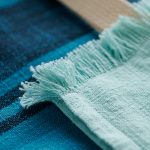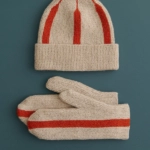Felted Wool Vest

The inspiration (and challenge!) for me here was to cut, shape, fold and stitch a simple yard-long piece of wool felt into a stylish vest that we would all love! The design process was a fascinating exploration of pared-down construction. How to get the biggest effect out of the smallest gestures?

The result is this wonderfully flowing Felted Wool Vest. It has no seams, just two cuts, a couple of tucks and a pair of folds. A rectangle of wool, minimally manipulated, is turned into a sweeping wrap-of-a-vest with petal-like folds that gently cascade around you.

The natural raw edges of Dorr Mill’s wool are highlighted by Gumnut’s subtly rustic Tulips needlepoint yarn. One hundred percent mohair, the sweet, fuzzy texture of Tulips is a perfect complement to the untouched beauty of Dorr Mill’s Wool Yardage. Together they are magic!

Designed by Purl Soho designer, Laura Ferguson.
Materials

To make one 36-inch by 56-inch rectangular vest, measuring 14 inches across the back:
- 1 yard of Dorr Mill’s Wool Yardage in the color Natural. (*Before you start you will need to felt the wool by washing it in hot, rinse in cold, drying it for 20 minutes and then pressing it flat.)
- 1 skein of Gumnut’s needlepoint yarn Tulips in the color 329
- Embroidery needles
- Pencil or Chaco Pen
Pattern
Measure, Mark and Cut for the Armhole

First things first, make sure the yard piece of fabric is ‘squared-up’, meaning that the adjacent sides are at 90 degree angles and the fabric doesn’t have any slanted sides. Use a straight edge and rotary cutter to trim any edges that need straightening.
Fold fabric in half along the short side, so that it looks like a 36 inch tall by 28 inch wide rectangle.
Use a Chaco Marker or pencil to draw a rectangle that is 8 inches tall by 2 inches wide as indicated in the picture above. The bottom edge of the rectangle will be is 14 inches from the bottom edge of the fabric and the inside edge of the rectangle will be 7 inches in from the folded edge.
Cut out the rectangle.
SIZING NOTE: If you are petite or short waisted, you might want to cut an inch off the bottom of the rectangle. If you do so, the armhole would begin 13 inches above the bottom edge. Similarly, you can bring the armholes closer together by placing them closer to the folded edge, 6 3/4-inches or 6 1/2-inches, rather than 7 inches from the folded edge.

With the fabric folded in half, you can use the cut out rectangle as a template to draw the second armhole, or you can simply flip the folded rectangle over, so the folded edge is on the left, and follow the steps above.
Measure and Mark for the Darts

Once again, orient the rectangle so it is folded in half, use a pencil to draw a 7 inch line, starting 4 inches from the bottom edge (3 inches if you are making a petite size) and 3 inches in from the folded edge.
Flip the folded fabric over and follow the steps above to make the second Dart Marking.
Measure and Mark for the Collar

Unfold the rectangle and lay flat with the Dart Markings towards the bottom of the fabric and that side of the fabric facing down.
Draw a 16 inch long line from the left edge of the rectangle, 6 inches off of the top edge, as indicated in the above picture.
Repeat on right edge. These are the Collar Markings.
Stitch the Edges

Using an embroidery needle and one ply of the Tulips yarn, whip stitch around all four edges of the rectangle.
Then whip stitch along the four sides of each armhole.
I took my stitches about 1/4-inch deep and 1/4-inch apart from one another.
Stitch the Darts and Collar

First, let’s make the Darts. Fold the fabric along one of the Dart Markings so that the line is facing you. Pinch the fabric between your finger and thumb of your non-stitching hand. With your stitching hand, whip stitch along the fold, taking the needle approximately 1/4-inch in from the fold. Make sure to take a few stitches at the start and at the end of the line to anchor the Dart, as shown above.
Repeat for second Dart.
Flip the fabric over so the Collar Markings are facing you. Use the same technique as for the Darts along the Collar Markings.

Throw your arms in the holes and you have yourself a vest! So simple, right?!!






Hi, thanks for a really cool project! Could you please show, or explain the collar stitching? Is it some sort of faux seam or gather? I don't see any indication of it in the beauty shots. Thanks again.
True artistic skill and minimalist design – no easy task. Thank you for once again providing a project which inspires. I can't wait to order these beautiful materials.
How about a front view?
Where does this collar stitching start?
Beautifully simple & looks very graceful and flattering…
Would I be able to alter this for a larger person?
I, too, am interested in seeing a better view of the collar stitching. Also, to clarify, it is stitched on the same side of the fabric as the dart stitching, yes? So then it ends up underneath the collar? Is this to enhance the fold/drape of the collar?
Hi Commenters!
Front view is coming soon! Stay tuned.
J Grahlfs and HRH Sarah
The collar runs from each side edge inward, 16 inches. It is stitched on the 'wrong side' and therefore creates a forced fold. Hopefully the Frontal views will help show this.
Thanks for writing in. –Laura
Hi K1P1,
First of all I love your name K1P1, that's amazing! Second of all, great question! Yes so easily adjusted for those more petitie or broader shouldered. The armholes are located 7 inches from the center fold, making a 14 inch back. If you locate these armholes farther off the center fold, let's say 8 inches, you will create a 16 inch back. It's as easy as that!
Similarly, if you are long chested, you can located the armholes an inch or so farther from the bottom edge, giving the piece some length. The collar is quite generous and therefore there is room to play the the vertical location of the armholes.
Hope this helps! –Laura
Hi Francie,
The Collar stitching is done on the OPPOSITE side as the Dart stitching, so that a fold is created bringing those top inches to the front and the stitching runs along the top edge of the created collar. I think the new pictures will help show this. Stay tuned! Thanks. –Laura
Do you think I can make this in a linen?
Hi Grace-
Linen would fray along the edges but if you don't mind that it would probably work fine, and have a beautiful drape. Thanks for getting in touch and please let us know how it goes.
Thank you!
Molly
Lovely and the forced folds are genius.
hi.
Is there a printable pattern for this which could be converted into cm, I’m finding it difficult and understand inches and yards without the whole thing laid out in front of me. Also can this fabric or similar be bought anywhere in Australia. Thanks
Hi Sarah.
We do have a print button!
If you’re on a desktop version of the site, you will find a “print†icon in the right column just below the date and tags. If you’re on a mobile version of the site, you will find a “print†icon below the pattern and above the comments.
Follow the easy on-screen instructions to delete whichever parts of the pattern you don’t want to print or save. For example, you may decide to shorten the pattern by omitting certain images or the list of materials.
Once you have it printed hopefully it’ll be easier to calculate the inches into centimeters.
Regarding the fabric. I’m not entirely sure where it’s available in Australia. We do ship there though!
Thanks for writing in.
Laura
great ves!Is there a printable copy of the instructions?
Hi Polly.
We do not have pre-printed patterns available, but we do have a print button!
If you’re on a desktop version of the site, you will find a “print†icon in the right column just below the date and tags. If you’re on a mobile version of the site, you will find a “print†icon below the pattern and above the comments.
Follow the easy on-screen instructions to delete whichever parts of the pattern you don’t want to print or save. For example, you may decide to shorten the pattern by omitting certain images or the list of materials.
Thanks for writing in.
Laura
Do you think the vest could be made with a flannel or a knit, like a t-shirt material, if I wanted to make it washable?Or would it fray?- sorry-I’m a newbie-
Hi Polly.
I think it could! I think the flannel would be more predictable/similar since it’s also a woven fabric. As for the edges, either before you work the blanket stitch or while working the blanket stitch you could work a hand rolled edge hem to help prevent any fraying.
Thanks for writing in. Let us know how it goes!
Laura
Hello! Lovely pattern! Do you think this could this still work if I did not cut the wool for the collar, but simply folded/creased it along that line? For example – the collar is folded around the neck. What if I just continued that fold down the entire length of the collar?
Hi Maura,
Thanks for your kind words! If I understand correctly, you want to incorporate a seam/fold all the way around the shawl collar? If so, this is totally possible but will give you a sharp edge instead of a rolled shawl-like collar. Let me know if you still have questions!
Best of luck!
-Adam